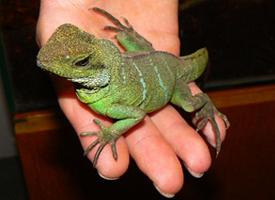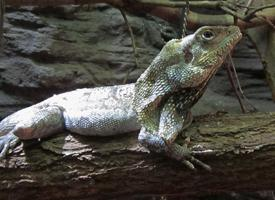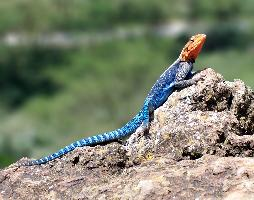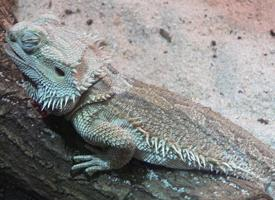
Známé také jako
- Agama vodní
Váhy a míry
| Délka | od 25 do 30 cm |
|---|---|
| Délka ocasu | od 40 do 70 cm |
Biologická data
| Délka života | od 10 do 15 let |
|---|
Popis zvířete
The Chinese water dragon (Physignathus cocincinus) is a fascinating and visually striking reptile that belongs to the family Agamidae. Native to the forests and swamps of Southeast Asia, including countries like Thailand, Vietnam, Laos, Cambodia, and parts of China, this species thrives in warm, humid environments that are close to bodies of water. The Chinese water dragon's distinctive appearance, coupled with its relatively docile nature, has made it a popular choice among reptile enthusiasts and pet owners around the world.An adult Chinese water dragon can reach lengths of up to 90 cm (about 3 feet), with males typically being larger and more vibrant in color than their female counterparts. The majority of their length is made up of their long, slender tail, which they use for balance and swimming. Their bodies are streamlined and built for agility, with strong, clawed limbs that allow them to climb and swim with ease.
The skin of the Chinese water dragon is a striking blend of green hues, ranging from bright jade to deeper, forest greens. This coloration provides excellent camouflage among the foliage of their natural habitat. Males often display brighter colors than females, with patches of blue or turquoise on the throat and belly, and a distinctive crest that runs from the head down the length of the spine, becoming more pronounced and vibrant during the breeding season. This crest is supported by elongated vertebral spines, giving the dragon a regal and imposing appearance.
Chinese water dragons have long, narrow heads with a row of spiny scales running along the sides of their jaws, cheeks, and neck. Their eyes are large and alert, with vertical pupils that allow them to accurately judge distance—a critical ability for a species that spends much of its time in trees. They also have a small, nuchal crest (a ridge of skin) behind their head, which is more pronounced in males.
In the wild, Chinese water dragons are semi-aquatic and arboreal. They are excellent climbers and spend a significant amount of time in trees, coming down to the ground or into the water to hunt or escape predators. Their diet is omnivorous, consisting mainly of insects, small mammals, and occasionally fruit. Their long, slender tails not only aid in swimming but also serve as a defensive mechanism, allowing them to whip at potential threats.
Breeding season sees males becoming more territorial and displaying vibrant colors to attract females. After mating, the female will lay a clutch of eggs in a nest dug into the moist soil, which she then covers and leaves to incubate. The young are independent from birth and receive no parental care, though they inherit the instinctive behaviors necessary for survival.
In captivity, Chinese water dragons require a large, humid environment that mimics their natural habitat, with access to both land areas and a sizable body of water for swimming. Proper UV lighting, temperature gradients, and a diet that reflects their omnivorous nature are essential for their health and well-being. When cared for properly, Chinese water dragons can live for up to 15 years, making them a long-term commitment as pets.
Despite their somewhat intimidating appearance, Chinese water dragons are known for their gentle demeanor, often showing curiosity towards humans and even enjoying interaction once trust is established. However, like all reptiles, they require careful handling to prevent stress and injury.
As a species, the Chinese water dragon is not currently listed as endangered, but it faces threats from habitat destruction and the pet trade. Conservation efforts and responsible pet ownership are crucial to ensuring that this magnificent creature continues to thrive in the wild and in homes around the world.
Podobná zvířata
Nové fotografie zvířat
Top 10 zvířat
- Chinese water dragon (Physignathus cocincinus)
- Galápagos tortoise (Geochelone nigra complex)
- Sea urchins (Echinoidea)
- Diana monkey (Cercopithecus diana)
- Dolphin gull (Leucophaeus scoresbii)
- Moustached guenon (Cercopithecus cephus)
- Japanese macaque (Macaca fuscata)
- Royal penguin (Eudyptes schlegeli)
- Hen harrier (Circus cyaneus)
- Common house mosquito (Culex pipiens)


